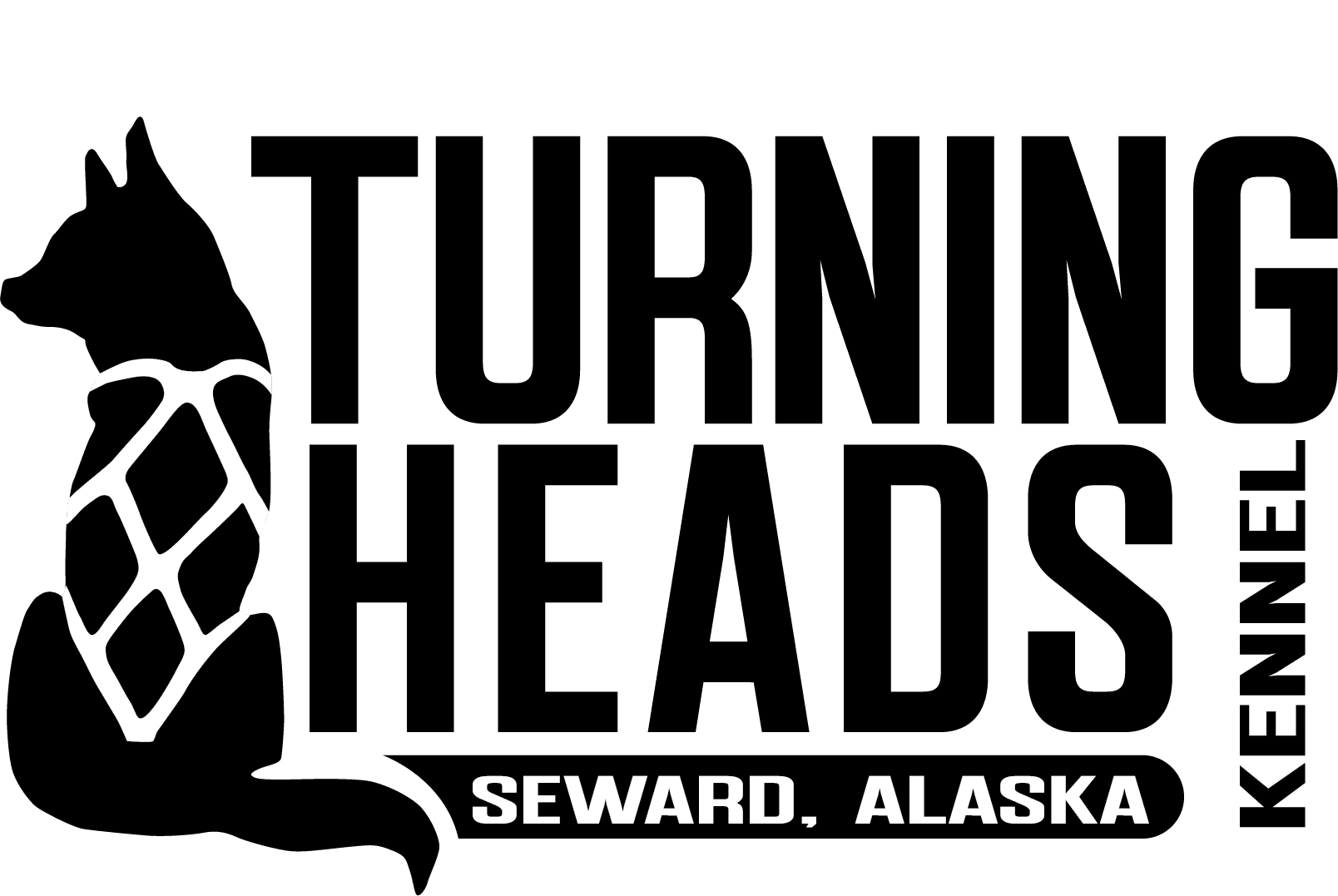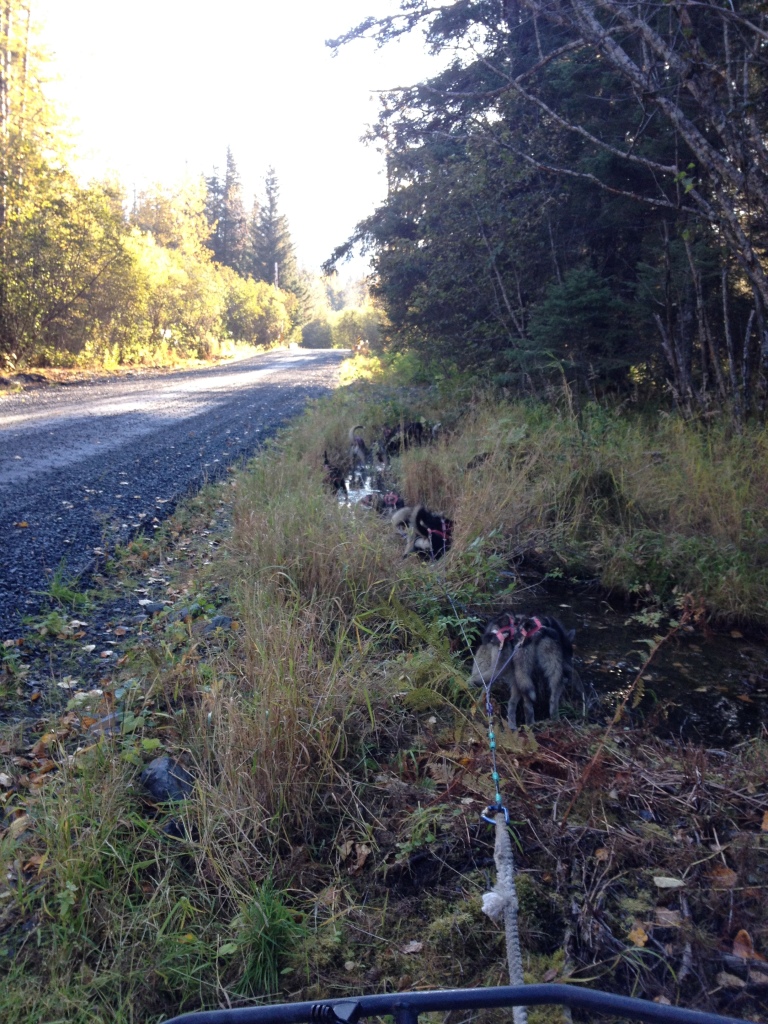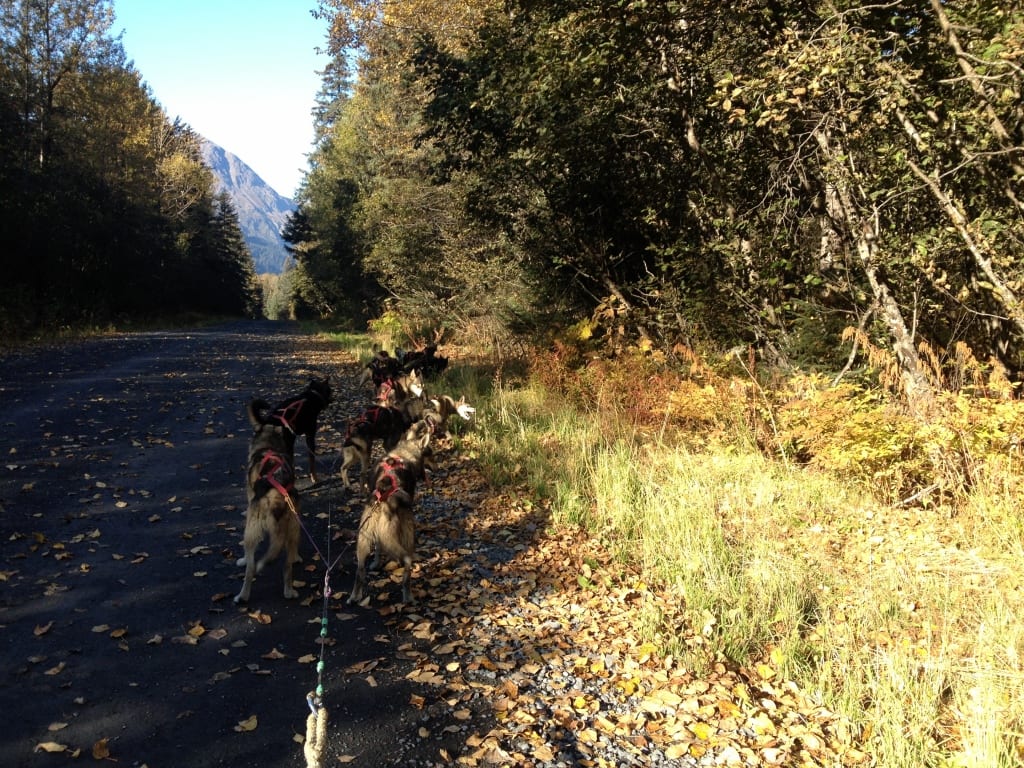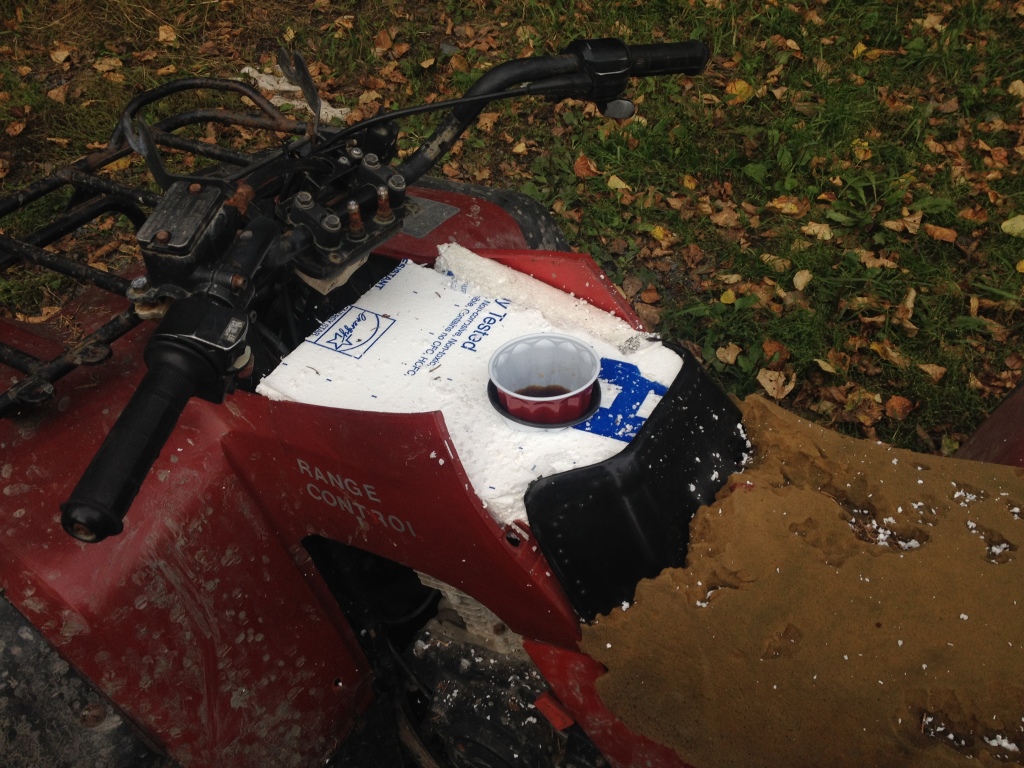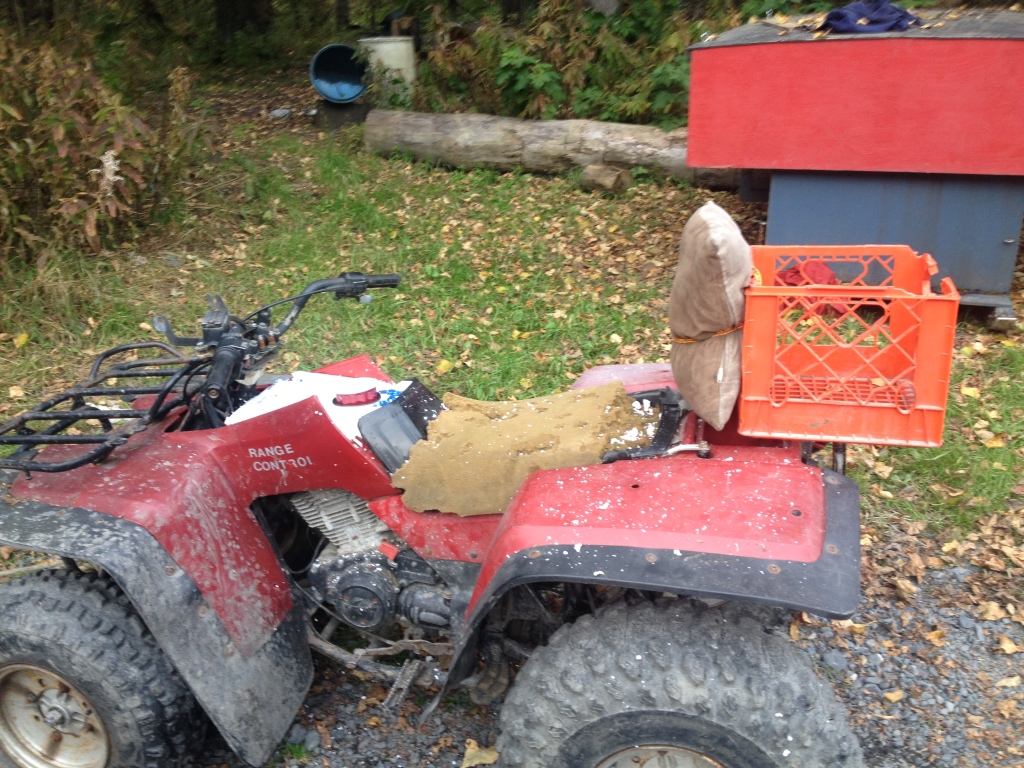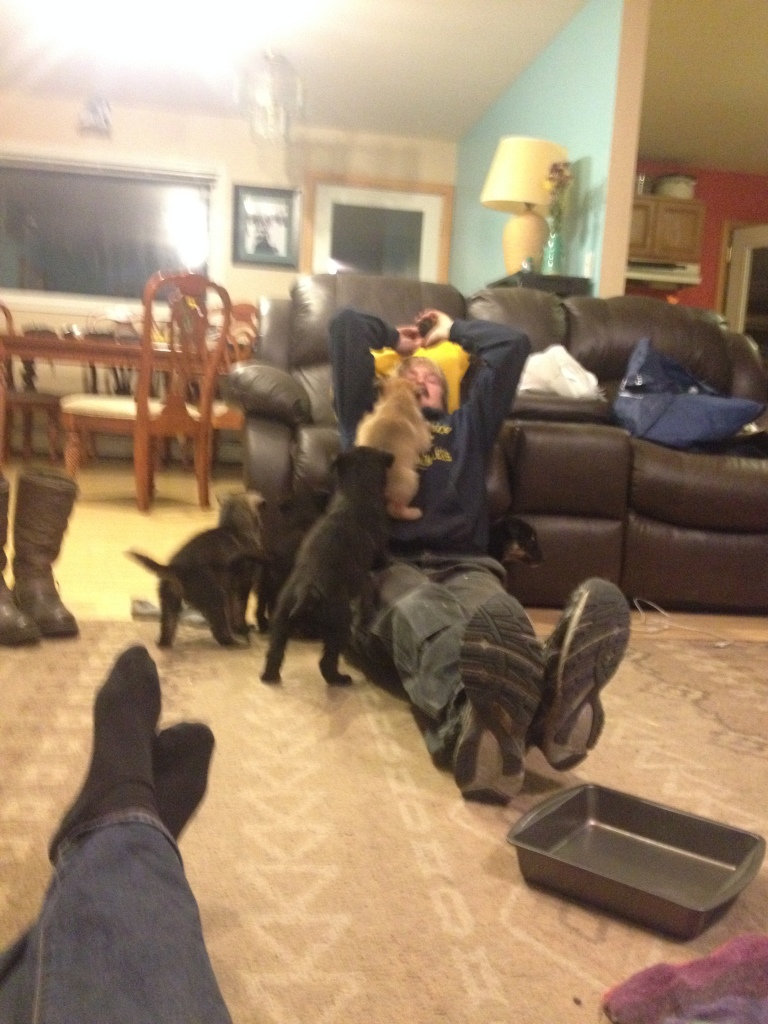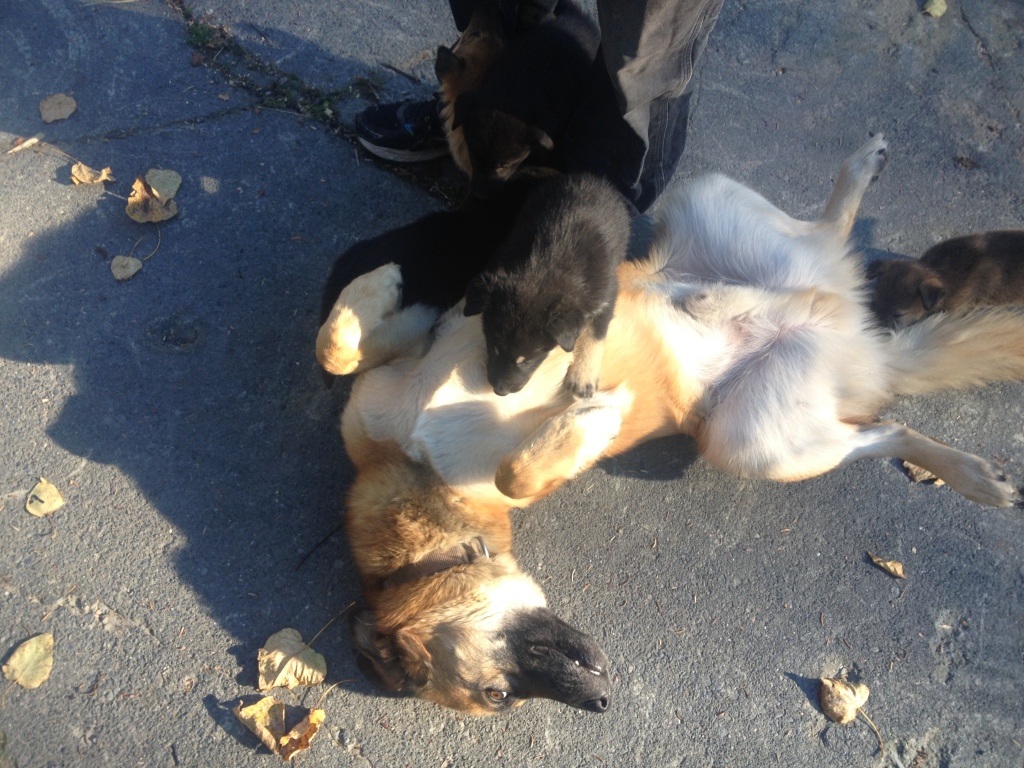On Monday I didn’t want to run dogs but did anyways. That’s what you are supposed to do, isn’t it? The dogs needed to get out and were eager to go but I was in a funk. Iditarod, I told myself. So I rose reluctantly and headed out to the yard. The dogs eager heads popped out of their houses when they saw me. They quickly realized we were going to be heading out on a run.
I am slow and methodical when I hook up my dog team. I like them to be quiet but it takes time and patience for them to learn that. Today, they obliged sprawling out waiting as one by one their teammates joined them. When I hooked up my 8th dog, they finally started getting excited but I was able to calm them down.
“Good dogs,” I told them when they settled back down.
So I harnessed them up and they were patient with me, letting me take my time and reserving their excitement until the end when I had all 14 of them hooked up. They were excited. We took off and then —
Oh no!
An orange ball of enthusiasm rushed out of the woods and charged at my team. Before I knew it, I yelled: “MAX! GET OUT OF HERE!”
The ball of fur was Max, my pet dog. And when I yelled he turned remarkably fast, but not before my lead dogs brush him aside.
Ok, Disaster Averted. “Good boy Kermit!” I tell my lead dog. He didn’t let Max phase him and I sure wasn’t it going to let it phase me. I tried to calm myself and get that mediative composure that seems so engrained to dog mushing. Max has given me some great training the past few months and now he is slowly trotting behind the fourwheeler.
“Go home,” I growl. He looks at me and then slinks off as if to say “I was only trying to help.” And he has helped. He comes out of the woods at random intervals and uses his moose-sized body to charge the team. One of two things inevitably happens when he does this: my team is well behaved, ignores him, and continues down the trail… or all hell breaks loose. Max likes mayhem. But today there is no mayhem, today there are only dogs who listen and who know their job and who know that no matter what the big orange dog does, they just keep running.
Good.
So we continue on our run. And it’s starting to shape up nicely. They settle into a fast steady trot quickly. We are probably averaging about 9 or 10mph and I’ve finally partnered all the dogs in a way that I can stand. My team is a mess of gaits. Hardly anyone runs the same. I have the B-team, after all, but after several runs of moving dogs around, I’ve finally come up with some good pairs. Each dog matches their partner and they step in rhythm. I have the building blocks for a great team. Running with Travis for so many years though, I have caught on to some of his OCD about gaits, running, and rhythm and certain dogs, despite being great athletes, just don’t fit in. Finally though, I have matched them well:
Kermit* (m)– Bonnie (f)
Marlow (m) — Barkley*(m)
Sphinx (f) — Tamere*(f)
Dolly (f) — Varden (f)
Ayla (f) — Havoc (f)
Ginzu*(m)– Teddy (m)
Bud (m)– Big Guy*(m)
That’s the team I have been running and they look good together. But I am still missing a few dogs from my training pool: Pinky (f), Weiser* (m), Ray* (m), Monroe* (m), Mary*(f), and Madori*(f). I have 10 dogs who have run Iditarod*, 9 puppies, and 1 adult (Bud)who has never quite made it to race day.
We are starting to look really good and on this run, everyone is starting to finally gel. Yes. It’s happening. It’s hard not to get a little excited at how they work and move together.
So we keep running and we go by a neighbor’s house when all of a sudden — YIP YIP YIP — a small, pint size dog comes tearing across it’s yard and starts to chase me.
Oh no. One of my leaders, Bonnie, turns her head for a second to see what the commotion is. “Straight ahead!” I holler. The little dog keeps following me but isn’t gaining on me.
What do I do? I’m not sure if stopping is a good idea but I ams supposed to turn around in about 200 yards. I am terrified for the little dog. My dogs are well behaved. They are friendly. But this little dog wants to pick a fight with them. I have no idea what to expect from my own dogs — we routinely pass a Saint Bernard with gnashing teeth and a fat black labrador that likes to pretend its vicious, but these are big dogs and it’s become a game to my team. Those dogs have taught us how to speed up and run fast. They’ve taught the dogs discipline. So why would I expect my dogs to do anything but pass this little dog?
Because it weighed 15 lbs and it was wearing a sweater: my dogs had no idea what it was. Was it friend or foe?
We made the turn around and the little dog sat and watched us. My team picked up speed when they saw the small dog and the little dog began charging us head on.
Really? I asked in disbelief. You have to hand it to small dogs they are both brave and stupid. I don’t think this little dog quite knew the bargain it was trying to make with my team, so I stopped, got off my ATV, walked to the front of the team, and tried to get the little dog to go away. It just wouldn’t leave.
I could try to pass the dog — I am sure my team would pass it — but what if they didn’t? What if they thought this little dog was not a dog? What if they decided it was something like a porcupine? Sled dogs are famous for attacking porcupine out on the trail despite the fact that they get needle-nosed faces and then must spend hours having quills removed. Or what if this little dog tried to attack them? If it tried to bite one of my dogs, which I wouldn’t put it past the dog, would my dogs retaliate?
So we sat. We waited. My dogs barked saying “What the hold up?” The little dog was still determined to get in the middle of my team.
“Go Home!” I told the dog.
I sit and stared at me. My leaders eyed it as if to ask “What is that?”
We played a game of back and forth that lasted 5 minutes.
With enough cajoling the dog finally got off the road and well back into the woods. I didn’t wait. I got on the ATV hit the gas and we roared past the little dog.
Phew! Glad that’s over!
I thought I was in for a quieter run after this but when we made our next turn I spied, with horror, a flock of loose chickens on the side of the road. We were almost upon them when I noticed.
Maybe the dogs won’t notice. I told myself. I really hoped they didn’t. We slid by the chickens without the dogs noticing. I was so relieved. I did not want to see the chaos of having a chicken run through the team nor did I want to have to admit to my neighbor that one of my dogs ate her chickens. You see, getting one dog to go by chickens is easy but the more dogs you add to the equation the more dogs you have that could potentially be disobedient. It only takes one to think its a good idea. If one thinks its a good idea, if you aren’t quick about it, they all will quickly think its a good idea.
At this point I was only about 3 miles into my run and left with a question: Do I continue my run or should I wait? In order to continue my run I would have to run past the small dog and past the chickens at least another 10 times in order to get the mileage I wanted. I knew, at the very least, I had to run by the little dog to get back home.
So I ran back by and fortunately at this point someone must have noticed the little dog was missing because he was no longer out to chase me. And then the second question: do I continue my run? Do I hope the chickens have been put away?
I decided I would give it a shot. I came around through the neighborhood the reverse of what I did before. When I initially passed the chicken we were on the same side of the road and they were about 3 feet from my team. This time, I came from the other direction and called my team over so we would have the whole road between us. I eagerly scanned ahead to see if I could see the birds. I knew if I did see them I would simply call the dogs up and make them run faster. I figured that at faster speeds they would have to be more focused and would have less time to notice the birds.
But the chickens were gone.
Thank goodness.
We continued to have a great run. We ran about 14 miles before I decided that we should go home. Once in the yard the dogs were still eager so I decided to take them out for another quick loop and put on an additional 2 miles. What a mistake that turned out to be!
Dusk was settling in now and a woman was out walking her two small dogs on leashes. We see her frequently and pass without much hesitation. Today was different though. Today we passed and I got a small tangle with a dog so I stopped ahead of the woman. My leaders turned down a driveway and I went up to correct them. That was when the woman walking her dogs dropped the leash.
This small 10lbs dog came barreling through my parked team. Before I knew it my lead dogs (they are in training) were turned around looking at the little dog. My whole team just sat there staring at this dog, who kept barking at them.
I tried to get the little dog out of the middle but it was dodging my hands. I was calm. My dogs were calm. But this little dog was barking, darting back and forth, and trying to elicit excitement from my team. Fortunately, they stayed calm and inquisitive though they proceeded to dance around the little dog.
Eventually, I got it out of my team but we got massively tangled.
My lead dogs were next to my wheel dogs. My swing dogs were my lead dogs. There were tug lines wrapped around legs and the gangline had gotten tangled around my team. And my team just stood there. This would have been the opportune moment for a dog, or the whole team, to panic. It was a recipe for someone to get injured, but I remained calm and talked to them. “It’s ok, we’ll get you guys untangled” I undid tuglines and necklines and had a few dogs completely turned loose. They went over to the little dog, who was still there with its owner, wagged their tails at each other and came when I called them to get back to their place in the team.
I blocked the road and directed a few cars by as night settled in. “It’s ok” I kept reassuring the dogs while working out the tangles. The woman, who was watching this all unfold, must have thought I was nuts as I never stopped talking to my dogs.
Then, when I was almost in the clear the smaller of the two dogs got loose again. This time, my lead dogs held the team out. They knew they had a job to do and that they hadn’t done it before so now they better. The little dog tried to stir up trouble but my dogs, frustrated at our lack of mobility, were patient and it grew bored and ran back to its owner. I was proud of my team.
Eventually, after about 15 minutes, we sorted everybody out and we continued down the trail with a little more trust in each other, a little more patience, and a little bit closer to the startling line.
